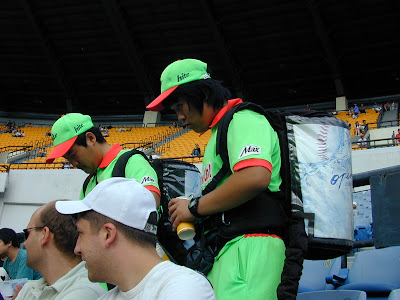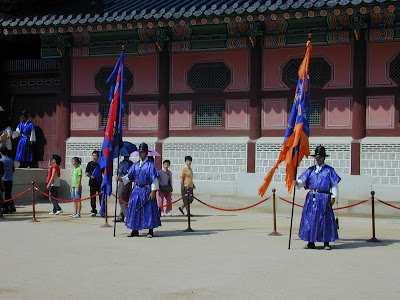Well, for starters, we had to clean the apartment and unpack. The apartment was actually quite dirty, and some of it couldn't be cleaned until we had found and bought appropriate cleaning supplies. Getting fully settled took a few days.
We also had to go shopping. Since we're only staying for 3 months, our intention was to avoid purchasing too many things. Erma's mother graciously provided us with a lot of basics, but we still ended up needing to buy some knives, trash cans, an iron, a blow dryer, and the like.
But most of the time we've spent exploring our neighborhood. Seoul is divided into large administrative districts called gu (구 區). Our district is Seodaemun-gu (서대문구 西大門區), "Great Western Gate District". It's located just outside of the old Seoul city walls, which no longer exist, where the large western gate entrance to the city once stood. (Dongdaemun and Namdaemun, the eastern and southern city gates, still exist.)
Gu are further subdivided into neighborhoods, called dong (동 洞). Our OfficeTel is located in Daeshin-dong (대신동 大新洞). This neighborhood sits just to the southeast of Yonsei University, which is itself in the foothills of the mountains that frame the north side of the city.
The OfficeTel's main entrance is on a rather large, busy, and noisy street, which runs past the main gate of Yonsei University about a quarter mile to our west. The street, Seongsan Street, looks like this:

The reason traffic is so light is that this picture was taken during the Chuseok holiday. Lots of buses run down this street, including the one that took us over to Gyeongbuk Palace on Chuseok.
More appealing is the back entrance of the OfficeTel, located on a small alley. The immediate neighborhood is full of upscale little cafes, restaurants, and bars, tucked discreetly into the nooks and crannies of the surrounding buildings. In the bottom floor of our OfficeTel there is a La Bonne Tarte (라 본느 타르트 Ra Bonneu Tareuteu) pastry cafe and a fancy wine restaurant called Côte (꼬뜨 Kkotteu). Erma's standing on the pastry side, of course.

Looking up and down the alley the view is like this:


Within two minutes' walk are, in addition to inexpensive Korean restaurants serving simple fare, Chinese, Vietnamese, Italian, French and German restaurants. A short block from us is a cafe called Princeton Square. There comfy seats are surrounded by full floor-to-ceiling bookshelves, and what wall space is left over is decorated with American college banners. Here we recently purchased cups of hot chocolate for just shy of $8 each. Erma finished off the latest Harry Potter novel while I, with the help of the electronic dictionary that was a gift from Erma's mother, worked my way through a short newspaper article in Korean on Seattle Mariners pitcher Cha Seung Baek.
Severance Hospital, which is part of Yonsei University and one of the best hospitals in the country, is very close by. On one occasion we saw a medical helicopter take off from the rooftop helipad.

Yonsei University is the result of a merger between Severance Hospital and Yonhi (연희 延禧) College. (The name Yonsei is a combination of the first syllables of Yonhi and Severance.) Here's a picture of Lance on the old part of campus, where the ivy-covered brick buildings look very much like those found at the older American universities on which Yonhi was modeled. The statue is of Horace Grant Underwood, a protestant missionary who founded the school (originally Chosun Christian College) and served as its first president.

About a 10-minute walk away is the bustling Shinchon area, an amazingly vibrant neighborhood with an incredibly high density of cafes, restaurants, bars, and amusement-park stalls where a young beau with good aim can win a giant stuffed Winnie-the-Pooh for his girlfriend. At night the sidewalks are so packed with young people out having fun that you can barely move. The signs, many neon, form a multilingual forest canopy over the streets.


Shinchon is also the location of the closest Metro station to us.
Here is a satellite map of the area where we live. Some of the places mentioned in this entry are tagged.
View Larger Map
If it doesn't appear properly, you can follow this link instead.
[Note: The Romanization of the title of this post was corrected from Dongnae to Dongne on March 14, 2008. The Korean word for 'neighborhood' is 동네, not 동내.]







































